library(tidyverse)
library(corrplot)
library(viridis)
library(igraph)
library(aricode)
library(sbm)
library(missSBM)
theme_set(theme_bw())Hierarchical and Spectral methods for Graph clustering
Lecture Notes
Preliminary
Functions from R-base and stats (preloaded) are required plus packages from the tidyverse for data representation and manipulation. The package igraph is a great library for network data manipulation (interface exists in Python). We will also use the package aricode for computing clustering metrics. missSBM contains our illustrative data set.
options(tinytex.engine = 'xelatex')1 Introduction
1.1 Network data and binary graphs: minimal notation
A network is a collection of interacting entities. A graph is the mathematical representation of a network.
In what follow, a graph \mathcal{G}=(\mathcal{V},\mathcal{E}) is a mathematical structure consisting of
- a set \mathcal{V}=\{1,\dots,n\} of vertices or nodes
- a set \mathcal{E}=\{e_1,\dots,e_p:e_k=(i_k,j_k)\in (\mathcal{V}\times\mathcal{V})\} of edges
- the number of vertices |\mathcal{V}| is called the order
- the number of edges |\mathcal{E}| is called the size
The connectivity of a binary undirected (symmetric) graph \mathcal{G} = (\mathcal{V},\mathcal{E}) is captured by the |\mathcal{V}|\times |\mathcal{V}| matrix Y, called the adjacency matrix (Y)_{ij} = \begin{cases} 1 & \text{ if } i \sim j,\\ 0 & \text{otherwise}. \end{cases} For a valued of weighted graph, a similar definition would be
(Y)_{ij} = \begin{cases} w_{ij} & \text{ if } i \sim j,\\ 0 & \text{otherwise}. \end{cases} where w_{ij} is the weight associated with edge i\sim j.
1.2 The French political Blogosphere
The frenchblog2007 data is a network dataset which consists of a single day snapshot of over 200 political blogs automatically extracted the 14 October 2006 and manually classified by the “Observatoire Présidentielle” project. It is part of the missSBM package. It is provided as an igraph object with 196 nodes. The vertex attribute “party” provides a classification of the nodes.
data("frenchblog2007")
summary(frenchblog2007)IGRAPH 7b93b75 UN-- 196 1432 --
+ attr: name (v/c), party (v/c)igraph::V(frenchblog2007)$party %>% table() %>% as_tibble() %>% rmarkdown::paged_table()A visual representation of the network data with nodes colored according to the political party each blog belongs to is achieved as follows:
Show the code
plot.igraph(frenchblog2007,
vertex.color = factor(V(frenchblog2007)$party),
vertex.label = NA
)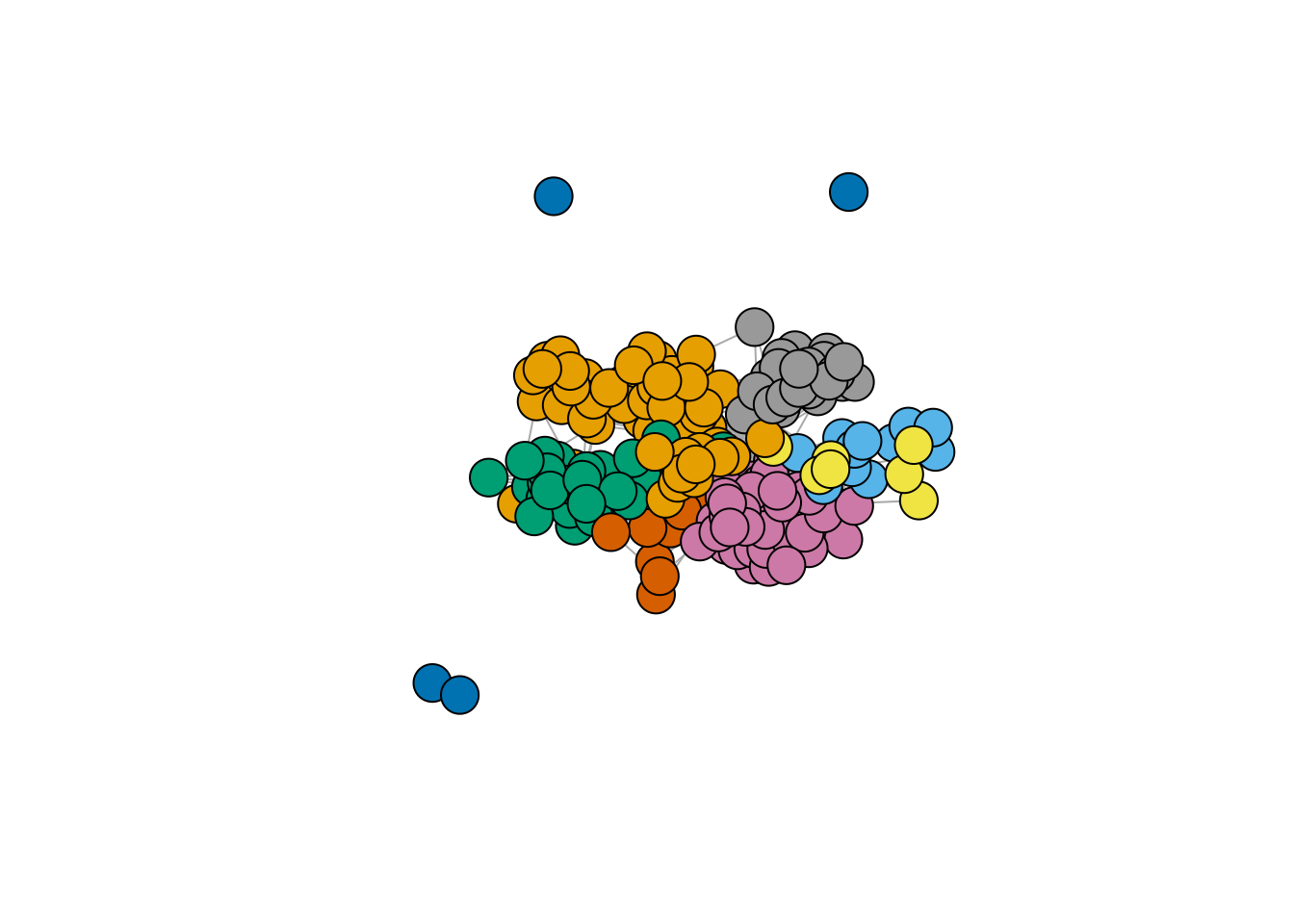
Another commonly used representation is via a matrix view, where the adjacency matrix is re-ordered column-wise and row-wise according to a predefined classification. In the frenchblog2007 data, nodes are originally reordered according to their party:
Show the code
frenchblog2007 %>% as_adj(sparse = FALSE) %>% plotMyMatrix(clustering = list(row = factor(V(frenchblog2007)$party)))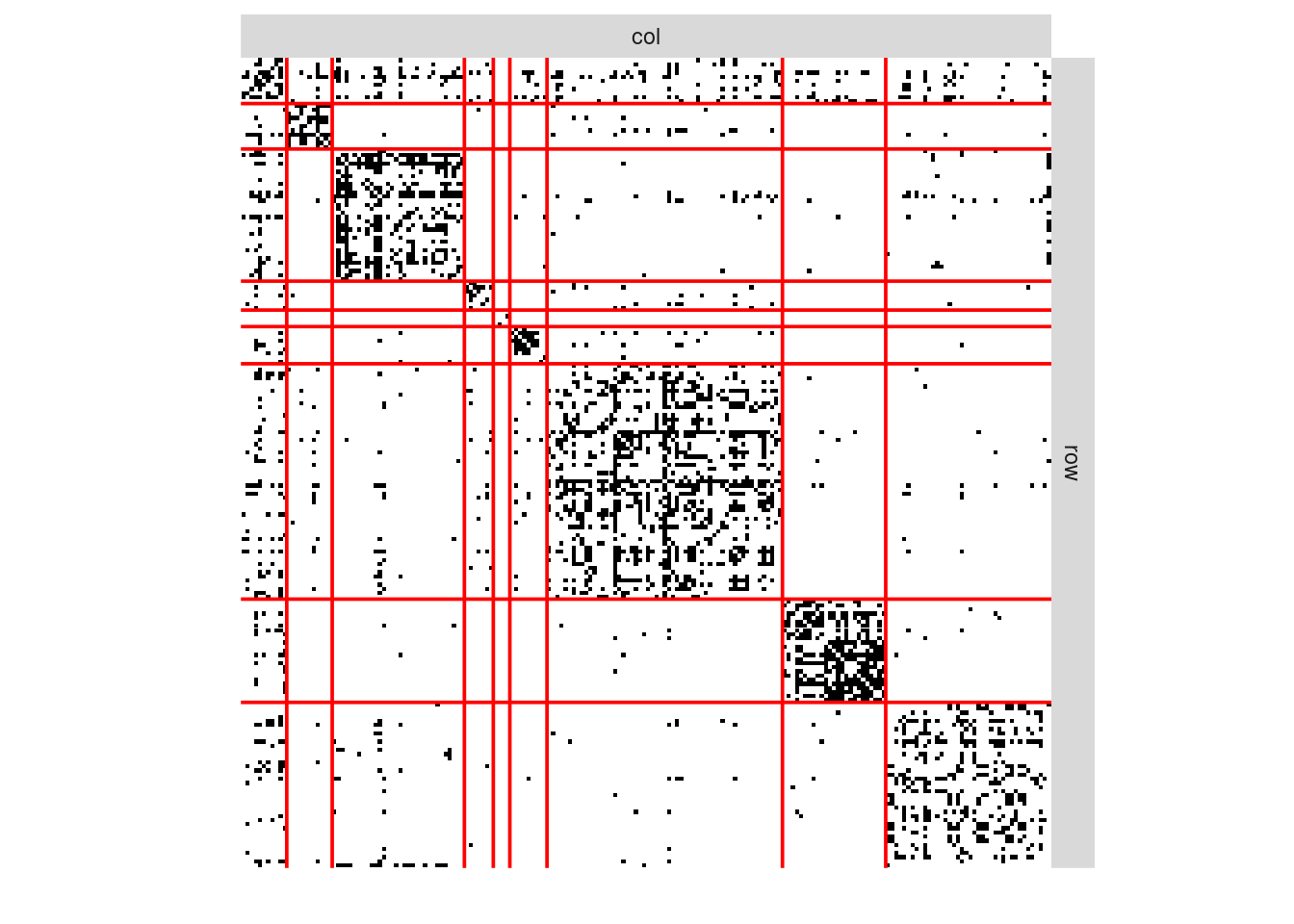
In this example, one can see that the pattern of connections between the nodes is highly related to the blog classification (the political party). However, just like with any kind of clustering, this is not always the case: the data may support a natural grouping of the node which is not necessarily related a predefined classification.
For convenience, in the following,
- we remove the isolated nodes or node with degree equal to one1
- we denote by Y the adjacency matrix encoding the network
- we extract the political party of the nodes as a categorical variable
Our objective is now to automatically find a partitioning of the node, i.e. a clustering, that groups together nodes with similar connectivity pattern. This is known as graph clustering.
blog <- frenchblog2007 %>% delete_vertices(which(degree(frenchblog2007) <= 1))
party <- V(blog)$party %>% as_factor()
Y <- blog %>% as_adjacency_matrix()
n_nodes <- gorder(blog)
n_edges <- gsize(blog)
party %>% table() %>% as_tibble() %>% rmarkdown::paged_table()2 Graph partionning
2.1 Agglomerative Hierarchical Clustering (HAC)
2.1.1 General principle
The idea of HAC applies naturally to network data just as it applies to standard data set:
- Start with small clusters (e.g. one cluster \equiv one node)
- Merge the most similar clusters sequentially (and greedily)
- Stops when all nodes are in the same groups
This implies 2 Ingredients
- a dissimilarity measure (distance between nodes)
- a merging criterion \Delta (dissimilarity between clusters of nodes)
Given a dissimilarity d_{ij} between a pairs (i,j), the standard merging criterion between two clusters \mathcal{C}_k and \mathcal{C}_\ell based on d_{ij} are the followings:
- Single linkage (or minimum linkage):
\Delta(\mathcal{C}_k, \mathcal{C}_\ell) = \min_{\mathbf{x}_i \in \mathcal{C}_k, \mathbf{x}_j \in \mathcal{C}_\ell} d(\mathbf{x}_i, \mathbf{x}_j)

- Complete linkage (or maximum linkage):
\Delta(\mathcal{C}_k, \mathcal{C}_\ell) = \max_{\mathbf{x}_i \in \mathcal{C}_k} \max_{\mathbf{x}_j \in \mathcal{C}_\ell}d_{ij}

- Average linkage (or group linkage):
\Delta(\mathcal{C}_k, \mathcal{C}_\ell) = \frac{1}{|\mathcal{C}_k||\mathcal{C}_\ell|} \sum_{\mathbf{x}_i \in \mathcal{C}_k}\sum_{\mathbf{x}_ \in\mathcal{C}_\ell} d_{ij}
- Ward’s criterion (distance to the mean - ‘average’ node \mu_\mathcal{C} )
\Delta(\mathcal{C}_k, \mathcal{C}_\ell) = \sum_{i \in \mathcal{C}_k} \left( d^2(i, \mathbf{\mu}_{\mathcal{C}_k \cup \mathcal{C}_\ell} ) - d^2(i, \mathbf{\mu}_{\mathcal{C}_k}) \right) + \sum_{j \in \mathcal{C}_\ell} \left( d^2(j, \mathbf{\mu}_{\mathcal{C}_j \cup \mathcal{C}_\ell} ) - d^2(j, \mathbf{\mu}_{\mathcal{C}_\ell}) \right)
When d is the Euclidean distance,
\Delta(\mathcal{C}_k, \mathcal{C}_\ell) = \frac{2|\mathcal{C}_k||\mathcal{C}_\ell|}{|\mathcal{C}_k|+|\mathcal{C}_\ell|}d^2(\mu_{\mathcal{C}_k}, \mu_{\mathcal{C}_\ell}) Then, for two partitions \mathcal{P}, \mathcal{P}' such as = \mathcal{P}(\mathcal{C}_1, \dots,\mathcal{C}_K) is at one level of the hierarchy and \mathcal{P}' is \mathcal{P} once \mathcal{C}_k, \mathcal{C}_\ell merged, we have
I_W(\mathcal{P}') - I_W(\mathcal{P}) = \frac{|\mathcal{C}_k||\mathcal{C}_\ell|}{|\mathcal{C}_k|+|\mathcal{C}_\ell|}d^2(\mu_{\mathcal{C}_k}, \mu_{\mathcal{C}_\ell}) = \frac{1}{2} \Delta(\mathcal{C}_k, \mathcal{C}_\ell). where we the inertia measures the homogenity of the size-K clustering
I_W = \sum_{k=1}^K \sum_{i \in \mathcal{C}_k} d^2(i,\mu_{\mathcal{C}_k}), \quad I_B = \sum_{k=1}^K |\mathcal{C}_k| d^2(\mu_k, \mu)
Thus, at each step, Ward limits the loss (increase) of the intra (inter) class variance. We recognize the same criteria as in the K-means algorithm.
We can apply this principle to the blog network. Let us start by using a very simple distance based on the adjacency matrix
D_basic <- 1 - as_adj(blog)
hc_basic <- hclust(as.dist(D_basic), method = "ward.D2")
plot(hc_basic, labels = FALSE)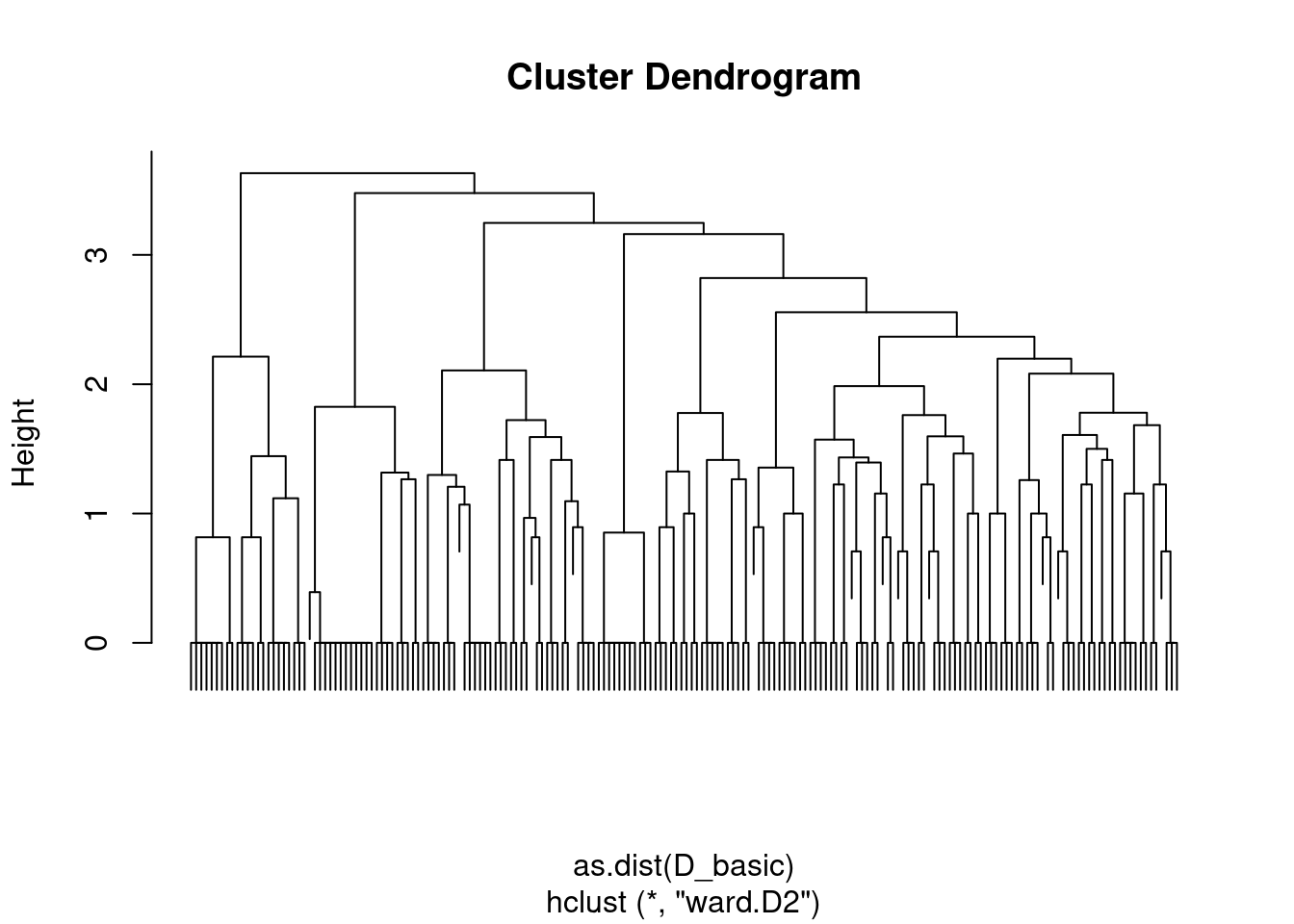
With this distance, we consider nodes as similar when they are neighbors. A finest and smoothest way of quantifying similarity between node is to rely on the notion of shortest-path: we measure similarity between pairs of nodes by the length of their shortest path. This can be computed quickly with igraph
D_path <- igraph::distances(blog)This distance exhibits a strong block-wise pattern that connects to communities
Show the code
corrplot::corrplot(D_path, tl.pos = 'n', is.corr = FALSE)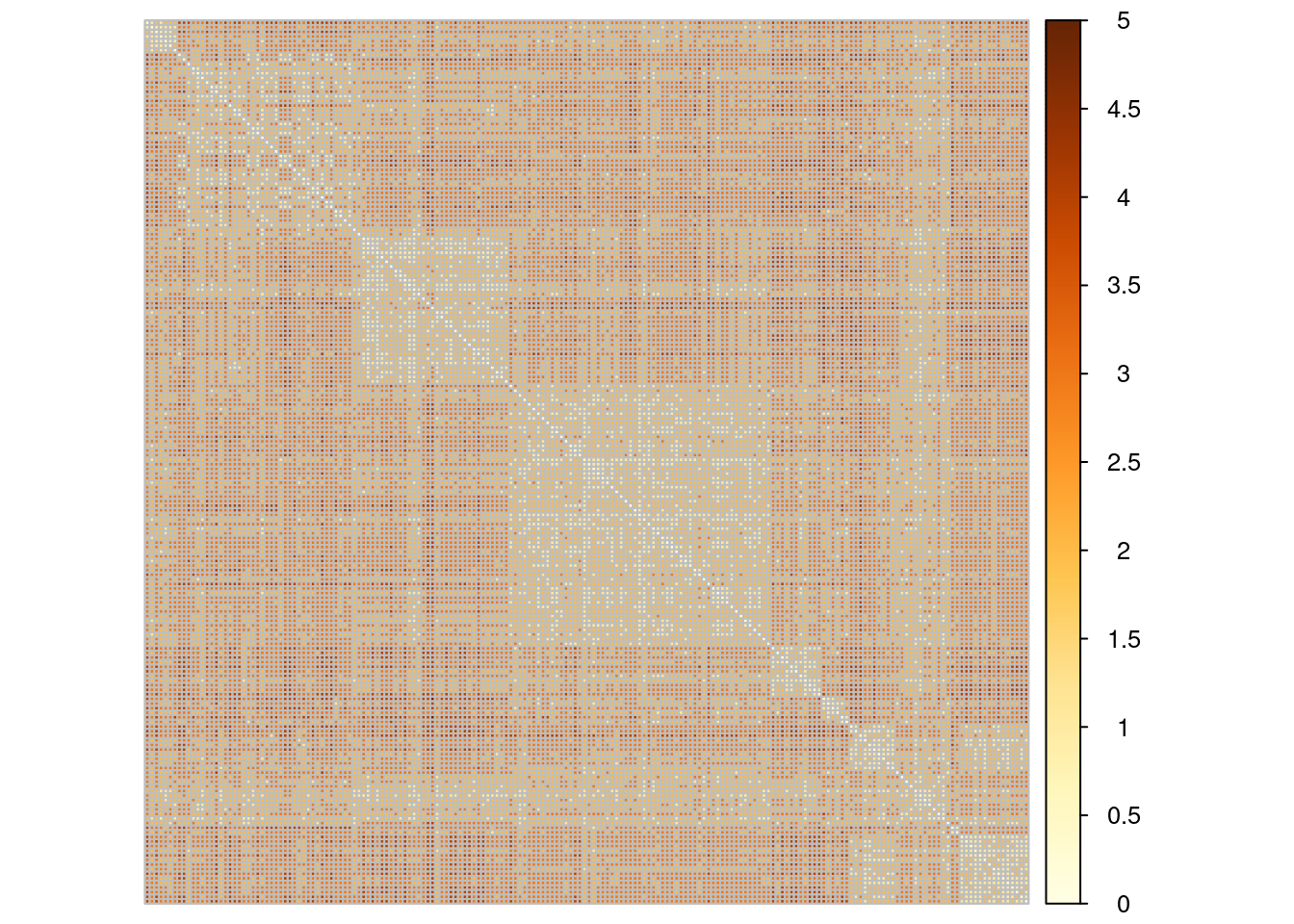
The corresponding dendrogram (hierarchy) obtained with Ward’s criterion is well balanced.
hc_path <- hclust(as.dist(D_path), method = "ward.D2")
plot(hc_path, labels = FALSE)
We can now check whether the clustering found is matching some external/prior knowledge that we have (here, the political party for instance). Many metrics for comparing several clusterings are available. We chose the popular Adjusted Rand Index (Rand (1971), Steinley (2004)):
nb_cluster <- 1:30
perf <- data.frame(
nb_cluster = nb_cluster,
adjancency = apply(cutree(hc_basic, nb_cluster), 2, ARI, party),
shortest_path = apply(cutree(hc_path , nb_cluster), 2, ARI, party))The gain is clear when considering the more sound distance based on shortest-path.
Show the code
perf %>%
pivot_longer(-nb_cluster, names_to = "distance", values_to = "ARI") %>%
group_by(distance) %>%
ggplot() + aes(x = nb_cluster, y = ARI, color = distance) + geom_line() +
theme_bw()
2.1.2 Some HAC algorithm specific to network data
We now consider a couple of methods building on the heuristic of HAC but explicitly dedicated to the task of graph clustering. In particular, we look at a dissimilarity that favors groups of nodes (modules) which are densely connected but sparsely connected to other modules.
Modularity (as introduced in Clauset, Newman, and Moore (2004))
For \mathcal{C} = \{C_1,\dots,C_K\} a candidate partition and f_{ij}(\mathcal{C}) the fraction of edges connecting vertices from C_i to C_j, the modularity of a partition is defined by
\mathrm{modularity}(\mathcal{C}) = \sum_{k=1}^K \left(f_{kk}(\mathcal{C}) - \mathbb{E}_{H_0}(f_{kk})\right)^2
The following algorithm try to optimize the modularity by successive merges:
hc_modularity <- cluster_fast_greedy(blog)
plot(hc_modularity, blog, vertex.label=NA)
Edge Betweeness (as introduced by Newman and Girvan (2004)): it is defined by the number of shortest paths that go through a edge in a graph.
hc_betweeness <- cluster_edge_betweenness(blog)
plot(hc_betweeness, blog, vertex.label=NA)
Regarding the similarity with our reference clustering (the party), the performances are at part with the preceeding methods, even if edge betweeness seems to capture more generic patterns:
perf$modularity <- hc_modularity %>%
as.hclust() %>% cutree(nb_cluster) %>% apply(2, ARI, party)
perf$betweeness <- hc_betweeness %>%
as.hclust() %>% cutree(nb_cluster) %>% apply(2, ARI, party)Show the code
perf %>%
pivot_longer(-nb_cluster, names_to = "distance", values_to = "ARI") %>%
group_by(distance) %>%
ggplot() + aes(x = nb_cluster, y = ARI, color = distance) + geom_line() +
theme_bw()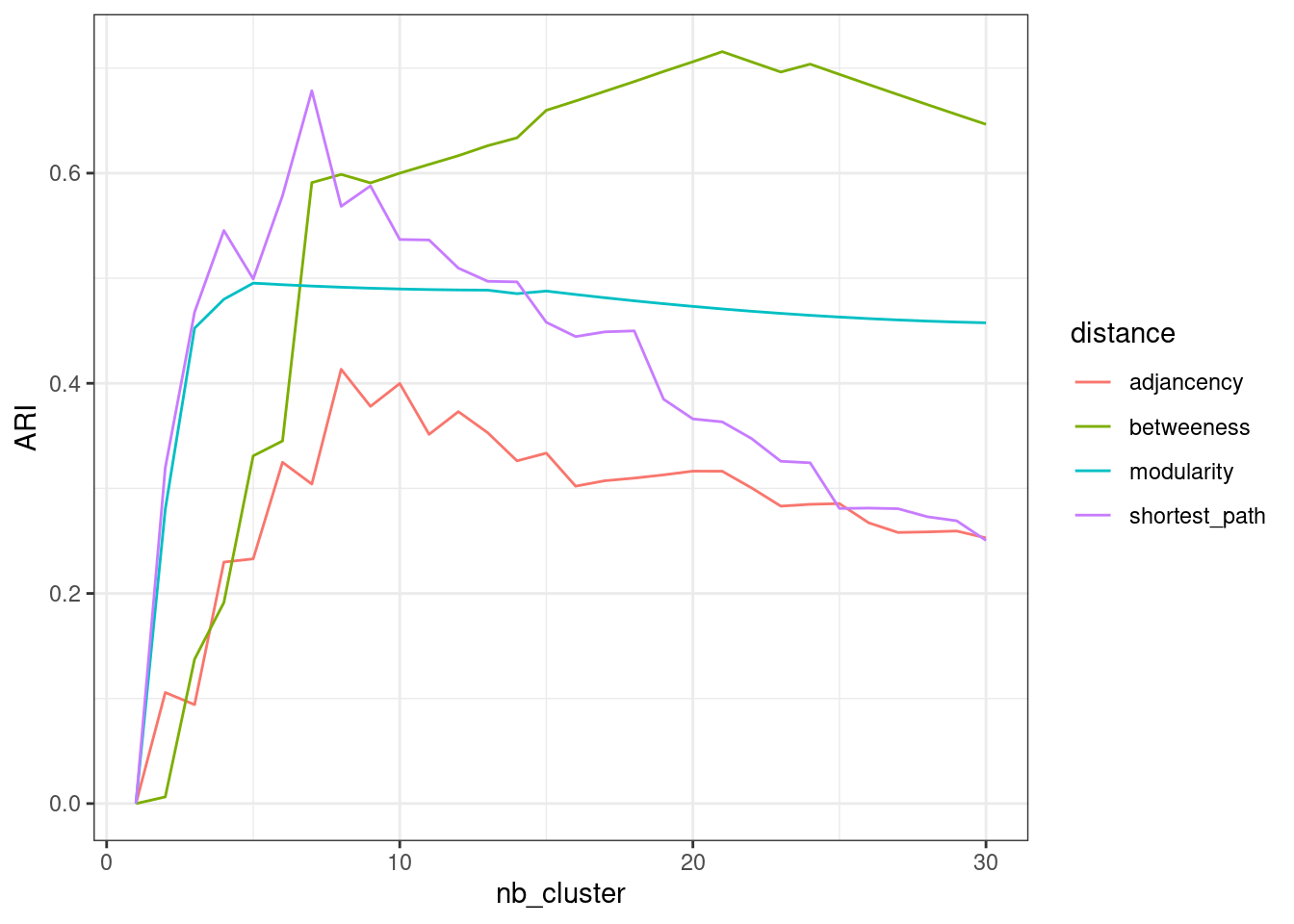
2.2 Spectral Clustering
The spectral clustering (see Von Luxburg (2007)) is a popular algorithm which can be seen as the equivalent of k-means algorithm for clustering network data. This algorithm is based on the spectral properties of graph, and in particular of the Laplacian matrix, which we briefly recap here. A detail introduction is made by (Chung and Graham 1997).
Here, we motivate the introduction of the Laplacian matrix via the graph-cut problem:
2.2.1 Graph-cut
First, we need to measure the importance or quantity of information associated to a node or a subset of nodes in the graph. The degree is a natural candidate: we define
\begin{aligned} \mathrm{degree}_i & = d_i = \sum_{j} Y_{ij}, \\ \mathrm{Vol}(\mathcal{S}) & = \sum_{i\in\mathcal{S}} d_i , \\ \end{aligned} where the volume of a subset \mathcal{S} of nodes is the cumulated degrees2.
For instance, in the French blog data set, the volume associated to each party would be
degree(blog) %>% split(party) %>% map_dbl(sum) %>%
as_tibble() %>% rmarkdown::paged_table()Second, let us define the cut between two set of nodes that form a partition in the graph:
\mathrm{cut}(\mathcal{V}_A, \mathcal{V}_B) = \sum_{i\in\mathcal{V}_A, j\in\mathcal{V}_B} Y_{ij}, \qquad \mathcal{V}_A \cup \mathcal{V}_B = \mathcal{V} that is, the cut is the sum of the weights of the edge set that connect the two components clV_A and \mathcal{V}_B. For instance, in this simple binary graph, the graph cut between \mathcal{V}_A= \{1,2,3,4,10\} and \mathcal{V}_B= \{5,6,7,8,9\} is 2.
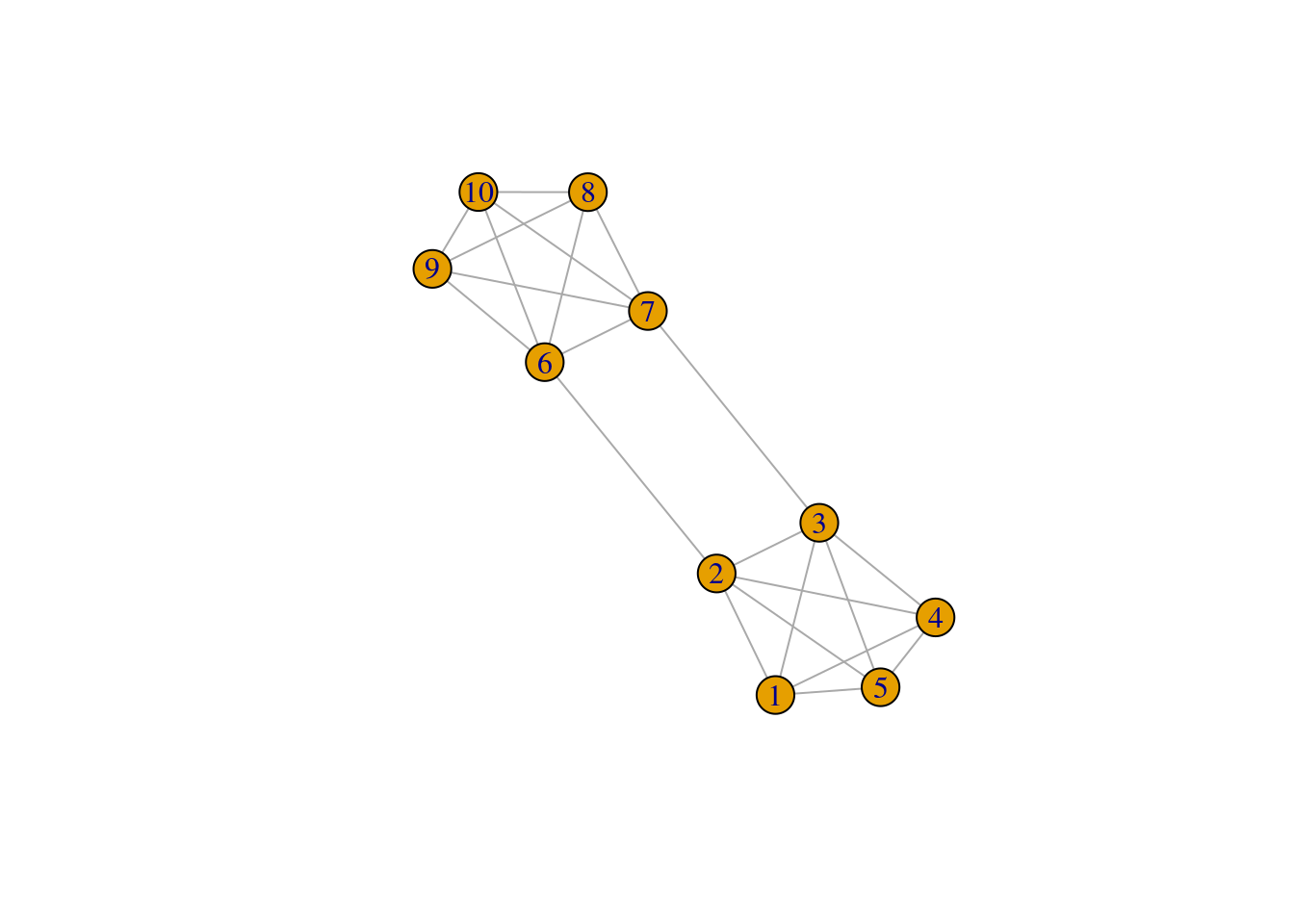
We can easily define a function to compute the cut
cut <- function(graph, A, B) {
res <- sum(as_adj(graph, type = "upper")[A , B])
res
}
V <- V(g)$name
A <- V[1:5]
B <- setdiff(V, A)
cut(g, A, B)[1] 2A natural criterion to cluster a graph into two homogeneous groups of node is to find the two sets (the partition) that minimizes the cut:
\argmin_{\{\mathcal{V}_A, \mathcal{V}_B\}} \mathrm{cut}(\mathcal{V}_A, \mathcal{V}_B)
A natural variant is to consider a normalized version of the, involving the connectivity between group relative to the volume of each groups:
\begin{aligned} \argmin_{\{\mathcal{V}_A, \mathcal{V}_B\}} \mathrm{cut}^{N}(\mathcal{V}_A, \mathcal{V}_B), \quad \mathrm{cut}^{N}(\mathcal{V}_A, \mathcal{V}_B) & = & = \frac{\mathrm{cut}(\mathcal{V}_A, \mathcal{V}_B)}{\mathrm{Vol}(\mathcal{V}_A) + \mathrm{Vol}(\mathcal{V}_B)} \\ \end{aligned}
Our function is easily modified to compute the normalized version of the graph-cut:
cut <- function(graph, A, B, normalized = TRUE) {
Y <- as_adj(graph, type="upper")
res <- sum(Y[A , B])
if (normalized) {
volA <- sum(Y[A, A])
volB <- sum(Y[B, B])
res <- res / (volA + volB)
}
res
}
A <- sample(1:gorder(blog), 100)
B <- setdiff(1:gorder(blog), A)
cut(blog, A, B)[1] 0.45207442.2.2 Solving the min-cut for 2 clusters
The above problem can be formalized as follows: a partition into two clusters of the graph can be defined by a vector of \{-1, 1\}^n. Indeed,
x = (x_i)_{i=1,\dots,n} = \begin{cases} -1 & \mathrm{if} \quad i\in \mathcal{V}_A, \\ 1 & \mathrm{if} \quad i\in \mathcal{V}_B. \\ \end{cases} Then, letting D the diagonal matrix of degrees, is not difficult to show that3
x^\top (D - Y) x = x^\top D x - ( x^\top D x - 2 \mathrm{cut} (\mathcal{V}_A, \mathcal{V}_B)), so that
\mathrm{cut} (\mathcal{V}_A, \mathcal{V}_B) = \frac12 x^\top (D - Y) x. From this, minimizing the normalized graph-cut is equivalent to solving an integer programming problem:
\begin{aligned} & \argmin_{\{\mathcal{V}_A, \mathcal{V}_B\}} \mathrm{cut}^{N}(\mathcal{V}_A, \mathcal{V}_B) \\[1.5ex] \Leftrightarrow \quad & \argmin_{x\in\{-1, 1\}^n} \frac{x^\top (D - Y) x}{x^\top D x}, \quad \text{s.c.} \quad x^\top D \mathbf{1}_n = 0, \end{aligned} where the constraint imposes only discrete values in x.
This problem is combinatorial (and NP-hard). However, if we relax to x\in[-1,1]^n, it turns to a simple eigenvalue problem
\argmin_{x\in[-1, 1]^n} x^\top (D - Y) x, \quad \text{s.c.} \quad x^\top D x = 1 \Leftrightarrow (D - Y) x = \lambda D x . where \mathbf{L} = D - Y is called the Laplacian matrix of the graph \mathcal{G}.
The n\times n matrix \mathbf{L} has the following properties: \mathbf{x}^\top \mathbf{L} \mathbf{x} = \frac{1}{2} \sum_{i,j} Y_{ij} (x_i - x_j)^2, \quad \forall \mathbf{x}\in\mathbb{R}^n .
- \mathbf{L} is a symmetric, positive semi-definite matrix,
- \mathbf{1}_n is in the kernel of \mathbf{L} since \mathbf{L} \mathbf{1}_n = 0,
- The first normalized eigen vector with eigen value \lambda> 0 is solution to the relaxed graph cut problem
The Laplacian is easily (and fastly) computed in R thanks to the igraph package. Let us compute this for the French blog graph:
L <- laplacian_matrix(blog)Spectral clustering exploits the spectral property of \mathbf{L}, by building heuristic based on the above properties. We review some variants in what follows.
2.2.3 Bi-partionning and the Fiedler vector
The Fiedler vector is the named sometimes given to the normalized eigen vector associated with the smallest positive eigen-value of \mathbf{L}. It thus solves the above relaxed graph-cut problem and can be used to compute a bi-partition of a graph.
Let us check how we can use theses quantities to partition the French blogosphere.
We first extract the Fiedler vector
spec_L <- eigen(L)
practical_zero <- 1e-12
lambda <- min(spec_L$values[spec_L$values>practical_zero])
fiedler <- spec_L$vectors[, which(spec_L$values == lambda)]Then, we plot the values of the Fiedler vector and color point according to the party to check if a part of the underlying structure of the network can indeed be found based on this quantity.
qplot(y = fiedler, colour = party) +
viridis::scale_color_viridis(discrete = TRUE)Warning: `qplot()` was deprecated in ggplot2 3.4.0.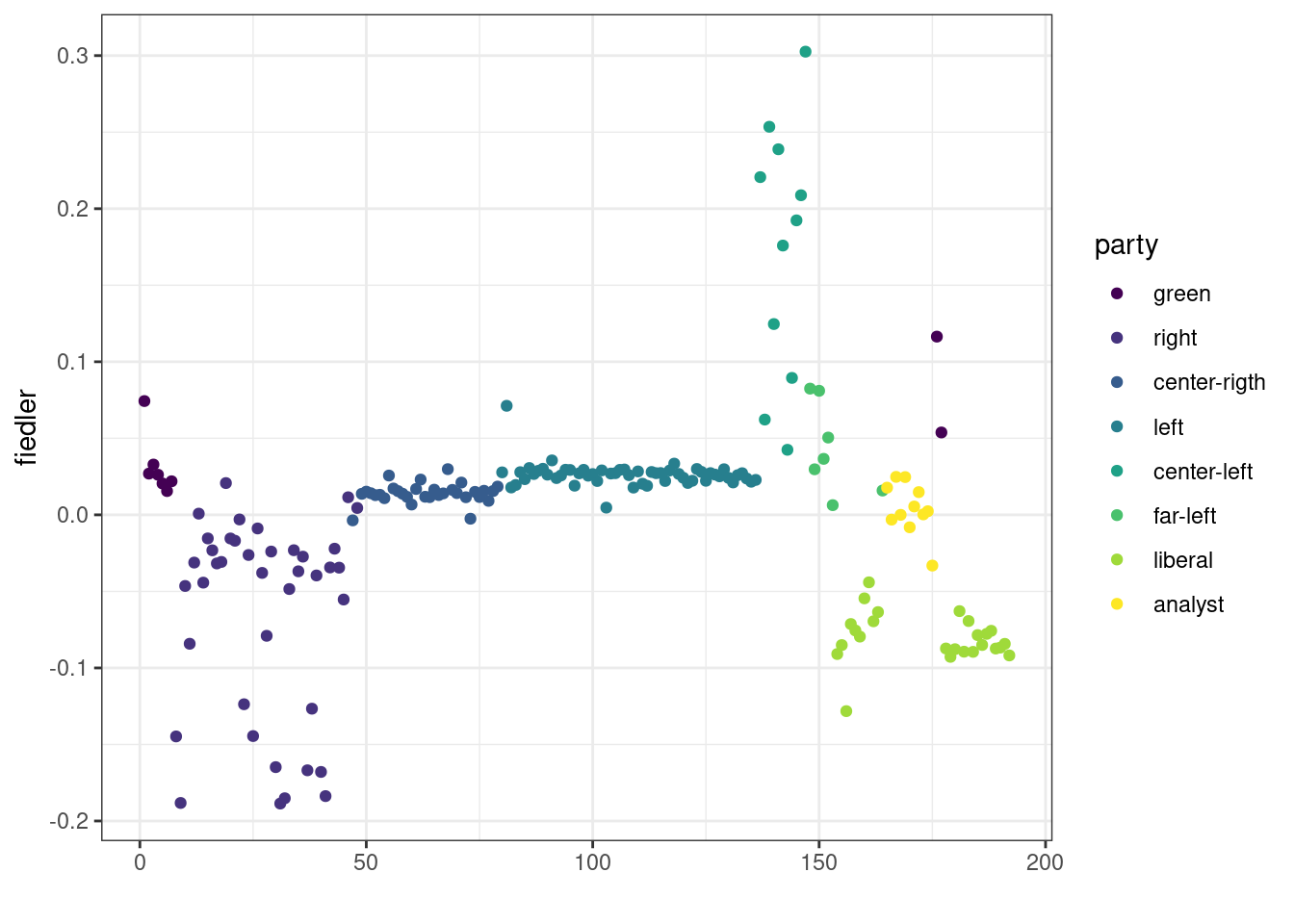
Also, and since the original motivation of the graph-cut is for two-way partionning, we collapse levels from the vector of party into a simplified left/right view (we keep the analysts into a third separated group)
left_vs_right <-
forcats::fct_collapse(party,
left = c("green", "left", "far-left", "center-left"),
right = c("right", "liberal", "center-rigth"),
analyst = "analyst"
)qplot(y = fiedler, colour = left_vs_right) +
viridis::scale_color_viridis(discrete = TRUE)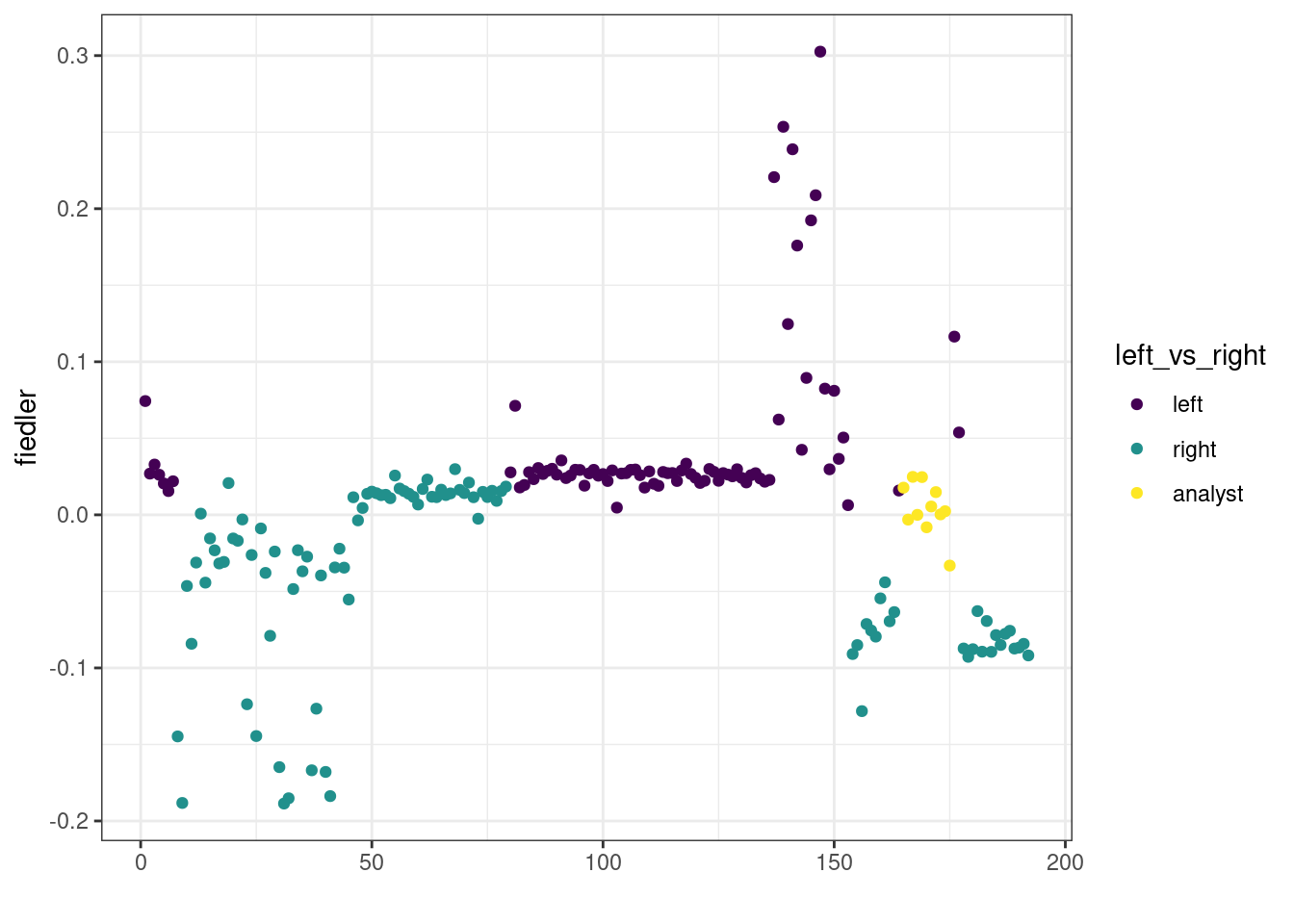
We can see that there exists an optimum value (or threshold) to separate left from right: if we compute the adjusted Rand index4 between a bi-partionning obtained by thresholding the Fidler vector and our reference vector left_vs_right, we can see that there exists an optimal threshold maximizing this quantity:
thresholds <- seq(-.1, .1, len = 100)
ARIs <- map_dbl(thresholds, ~ARI(left_vs_right, fiedler > .))
qplot(thresholds, ARIs) + geom_vline(xintercept = thresholds[which.max(ARIs)]) + theme_bw()
2.2.4 Spectral clustering algorithms
Various heuristics generalize the approach defined above to more than 2 groups. They all rely on the spectral property of the Laplacian given above, from which we can derive the following additional properties:
- The multiplicity of the first eigen value (0) of \mathbf{L} determines the number of connected components in the graph.
- The larger the second non trivial (positive) eigenvalue, the higher the connectivity of \mathcal{G}.
Based on these two properties, spectral clustering algorithms follow the following general principles:
- Compute spectral decompostion of \mathbf{L} to perform clustering in the eigen space
- For a graph with K connected components, the first K eigen-vectors are \mathbf{1} spanning the eigenspace associated with eigenvalue 0
- Applying a simple clustering algorithm to the rows of the K first eigenvectors separate the components
\rightsquigarrow The principle generalizes to a fully connected graph (with a single component): spectral clustering tends to separates groups of nodes which are highly connected together
The normalized Laplacian matrix \mathbf{L} (see Ng, Jordan, and Weiss (2002)) is defined by
\mathbf{L}_N = \mathbf{D}^{-1/2}\mathbf{L}\mathbf{D}^{-1/2} = \mathbf{I} - \mathbf{D}^{-1/2} \mathbf{Y} \mathbf{D}^{-1/2}.
The absolute Laplacian matrix \mathbf{L}_{abs} (see Rohe, Chatterjee, and Yu (2011)) is defined by
\mathbf{L}_{abs} = \mathbf{D}^{-1/2}\mathbf{Y}\mathbf{D}^{-1/2} = \mathbf{I} - \mathbf{L}_N, with eigenvalues 1-\lambda_n \leq \dots \leq 1-\lambda_2 \leq 1-\lambda_1 = 1, where 0=\lambda_1\leq \dots \leq \lambda_n are the eigenvalues of \mathbf{L}_N.
As described in Ng, Jordan, and Weiss (2002)
- Compute the laplacian matrix \mathbf{L};
- Compute the n\times K matrix \mathbf{U} of eigen vectors with the K smallest eigen values
- Normalize \mathbf{U} row-wise
- Apply k-means to (\tilde{\mathbf{U}}_i)_{i=1,\dots,n}
spectral_clustering <- function(graph, nb_cluster, normalized = TRUE) {
## Compute Laplcian matrix
L <- laplacian_matrix(graph, normalized = normalized)
## Generates indices of last (smallest) K vectors
selected <- rev(1:ncol(L))[1:nb_cluster]
## Extract an normalized eigen-vectors
U <- eigen(L)$vectors[, selected, drop = FALSE] # spectral decomposition
U <- sweep(U, 1, sqrt(rowSums(U^2)), '/')
## Perform k-means
res <- kmeans(U, nb_cluster, nstart = 40)$cl
res
}Let use perform spectral clustering on the blogosphere for various number of group. We get similar performance than the best hierarchical clustering methods found above:
perf$spectral <- map(nb_cluster, ~spectral_clustering(blog, .)) %>% map_dbl(ARI, party)
perf %>%
pivot_longer(-nb_cluster, names_to = "distance", values_to = "ARI") %>%
group_by(distance) %>%
ggplot() + aes(x = nb_cluster, y = ARI, color = distance) + geom_line() +
scale_color_viridis(discrete = TRUE) + theme_bw()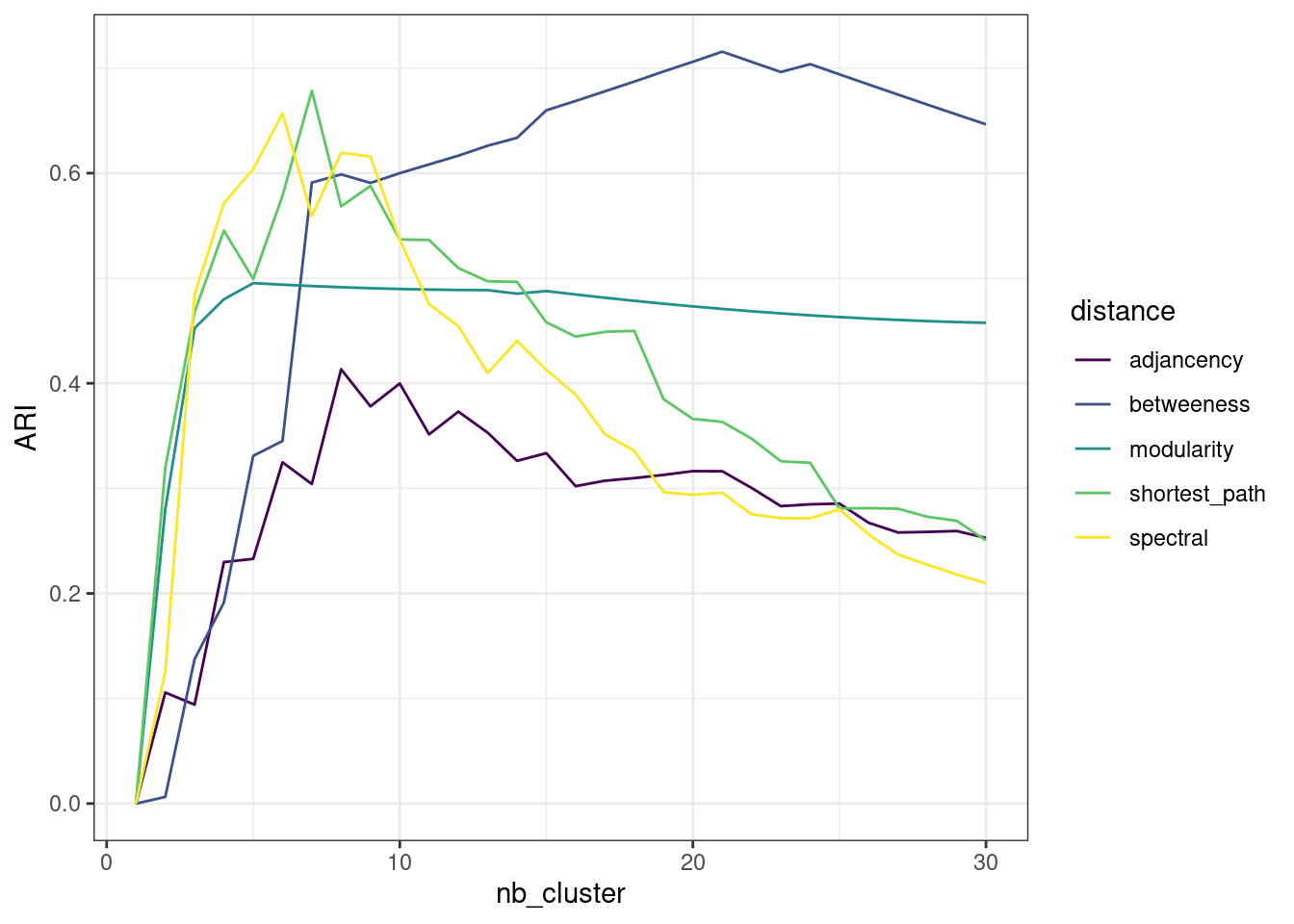
Once reorder according to the best clustering (obtained k=6) groups, the original data matrix looks as follows
Show the code
plotMyMatrix(as_adj(blog, sparse = FALSE),
clustering = list(row = spectral_clustering(blog, 6)))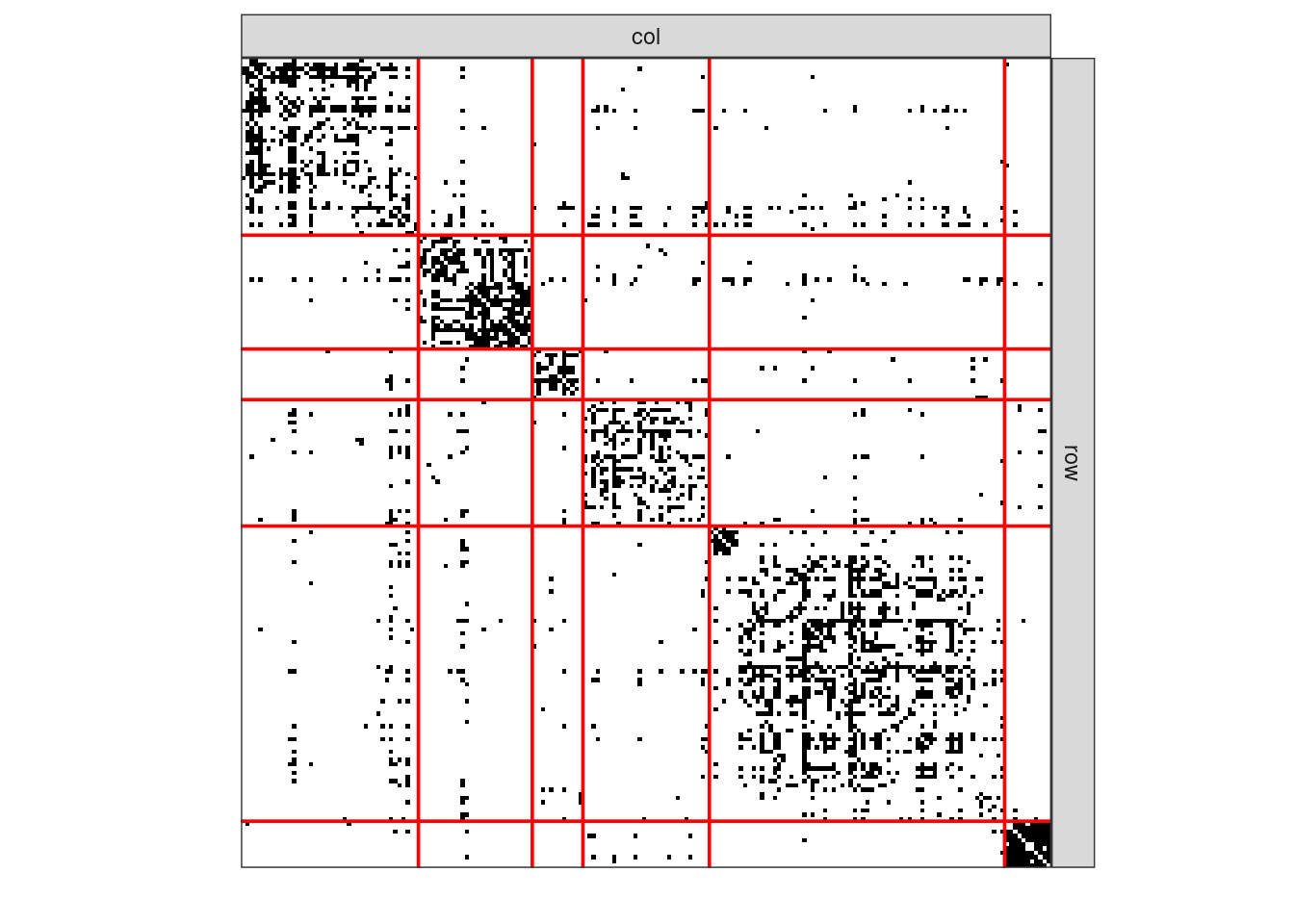
Hence, as expected, spectral clustering does a great job for recovering community structure in the network. Yet,
- What if other kinds of patterns (like star/hub nodes) structure the network
- What if we do not have any clue on the target number of cluster?
A model-based approach, like the one presented below, overcomes these issues